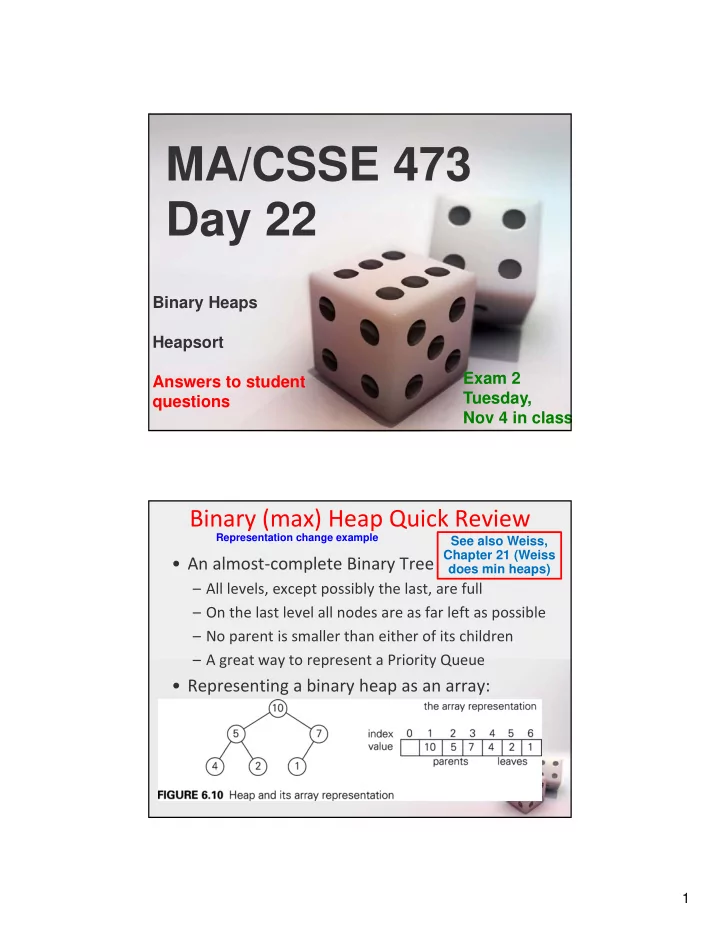

MA/CSSE 473 Day 22 Binary Heaps Heapsort Exam 2 Answers to student Tuesday, questions Nov 4 in class Binary (max) Heap Quick Review Representation change example See also Weiss, Chapter 21 (Weiss • An almost ‐ complete Binary Tree does min heaps) – All levels, except possibly the last, are full – On the last level all nodes are as far left as possible – No parent is smaller than either of its children – A great way to represent a Priority Queue • Representing a binary heap as an array: 1
Insertion and RemoveMax • Insertion: – Insert at the next position (end of the array) to maintain an almost ‐ complete tree, then "percolate up" within the tree to restore heap property. • RemoveMax: – Move last element of the heap to replace the root, then "percolate down" to restore heap property. • Both operations are Ѳ (log n). • Many more details (done for min ‐ heaps): – http://www.rose ‐ hulman.edu/class/csse/csse230/201230/Slides/18 ‐ Heaps.pdf Heap utilitiy functions Code is on-line, linked from the schedule page 2
HeapSort • Arrange array into a heap. (details next slide) • for i = n downto 2: a[1] a[i], then "reheapify" a[1]..a[i ‐ 1] • Animation: http://www.cs.auckland.ac.nz/software/AlgAni m/heapsort.html • Faster heap building algorithm: buildheap http://students.ceid.upatras.gr/~perisian/data _structure/HeapSort/heap_applet.html HeapSort Code 3
Recap: HeapSort: Build Initial Heap • Two approaches: – for i = 2 to n percolateUp(i) – for j = n/2 downto 1 percolateDown(j) • Which is faster, and why? • What does this say about overall big ‐ theta running time for HeapSort? Polynomial Evaluation Problem Reductiion TRANSFORM AND CONQUER 4
Recap: Horner's Rule • We discussed it in class previously • It involves a representation change. • Instead of a n x n + a n ‐ 1 x n ‐ 1 + …. + a 1 x + a 0 , which requires a lot of multiplications, we write • ( … (a n x + a n ‐ 1 )x + … +a 1 )x + a 0 • code on next slide Recap: Horner's Rule Code • This is clearly Ѳ (n). 5
Problem Reduction • Express an instance of a problem in terms of an instance of another problem that we already know how to solve. • There needs to be a one ‐ to ‐ one mapping between problems in the original domain and problems in the new domain. • Example: In quickhull, we reduced the problem of determining whether a point is to the left of a line to the problem of computing a simple 3x3 determinant. • Example: Moldy chocolate problem in HW 9. The big question: What problem to reduce it to? (You'll answer that one in the homework) Least Common Multiple • Let m and n be integers. Find their LCM. • Factoring is hard. • But we can reduce the LCM problem to the GCD problem, and then use Euclid's algorithm. • Note that lcm(m,n) ∙ gcd(m,n) = m ∙ n • This makes it easy to find lcm(m,n) 6
Paths and Adjacency Matrices • We can count paths from A to B in a graph by looking at powers of the graph's adjacency matrix. For this example, I used the applet from http://oneweb.utc.edu/~Christopher-Mawata/petersen2/lesson7.htm, which is no longer accessible Linear programming • We want to maximize/minimize a linear function n c i x , subject to constraints , which are linear i 1 i equations or inequalities involving the n variables x 1 ,…,x n . • The constraints define a region, so we seek to maximize the function within that region. • If the function has a maximum or minimum in the region it happens at one of the vertices of the convex hull of the region. • The simplex method is a well ‐ known algorithm for solving linear programming problems. We will not deal with it in this course. • The Operations Research courses cover linear programming in some detail. 7
Integer Programming • A linear programming problem is called an integer programming problem if the values of the variables must all be integers. • The knapsack problem can be reduced to an integer programming problem: n • maximize subject to the constraints x i v i 1 i and x i {0, 1} for i=1, …, n n x w W i i i 1 Sometimes using a little more space saves a lot of time SPACE ‐ TIME TRADEOFFS 8
Space vs time tradeoffs • Often we can find a faster algorithm if we are willing to use additional space. • Examples: 9
Recommend
More recommend